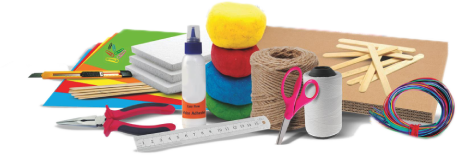The NID/NIFT Situation Test is not just about creativity—it’s about how well you can manipulate different materials to create innovative 3D models under time constraints. Whether you’re aspiring for NID or NIFT or even looking to build a strong design portfolio, mastering these materials is key to success!

At Art Forte, we specialize in NID Situation Test Preparation and NIFT Situation Test Preparation, ensuring students practice with the right materials and techniques. So, let’s dive into the top 10 materials you must master before your exam.
1. Paper & Cardboard
These are the backbone of many models. Learn to fold, cut, roll, and layer paper and cardboard to create sturdy and aesthetic structures. Pro tip: Experiment with different thicknesses for better structural strength.
2. Clay (Plasticine or Air-Dry Clay)
Clay is fantastic for sculpting organic shapes. Whether you need to create human figures, animals, or intricate textures, getting comfortable with clay can give you an edge in the Situation Test 2025.
3. Thermocol & Foam Sheets
Lightweight and easy to carve, thermocol (polystyrene) and foam sheets help in creating larger structures. However, they can be tricky to handle, so practice cutting and joining them neatly.
4. Wire & Pipe Cleaners
If your design involves intricate details, wire and pipe cleaners can add flexibility and durability to your model. They’re perfect for creating frames, skeletons, or even abstract art pieces.
5. Straws & Sticks (Ice Cream Sticks, Toothpicks, Bamboo Sticks)
These materials are excellent for creating architectural models or structures that require beams and pillars. Ice cream sticks are sturdy, while straws allow for flexible structures.
6. Cloth & Fabric Scraps
From miniature clothing to textured surfaces, fabric can add a unique touch to your model. If you’re preparing for design college, understanding fabric draping and layering can be useful.
7. Aluminum Foil
Aluminum foil is an underrated material that can add metallic textures, lightweight structures, and moldable surfaces to your models. Plus, it’s easy to shape and reuse!
8. Cotton, Sponge, and Tissue Paper
Soft materials like cotton, sponge, and tissue paper are useful for adding texture and volume to your model. Whether it’s fluffy clouds, a water effect, or cushioned elements, these materials help enhance your design.
9. Fevicol, Glue Guns & Tape
Your model is only as strong as its foundation! Fevicol, glue guns, and different types of tape (double-sided, masking, etc.) are essential for assembling pieces neatly and securely.
10. Recyclable & Found Objects
Thinking sustainably can add a unique touch to your model. Try incorporating recyclable materials like newspaper, bottle caps, buttons, or even old packaging to make your design more creative.
Why Practicing with These Materials is Crucial
The NID/NIFT Situation Test isn’t just about making something look good—it’s about using materials smartly and efficiently. Neatness, originality, and time management play a huge role in scoring well.
Need Extra Guidance?
At Art Forte, we offer:
✅ NID Coaching in Jaipur and NIFT Coaching in Jaipur and across India with hands-on situation test practice.
✅ Best Classes to develop artistic skills for design college entrance.
✅ Portfolio Prep & Online Portfolio Classes in India for students aiming for top international colleges like UAL, Parsons The New School, SCAD, and PRATT.
✅ Guidance for International Portfolio Preparation in India, including specialized coaching for Istituto Marangoni, Lasalle, and FIT New York.
If you’re serious about NID/NIFT Entrance Exam Preparation or aiming for a world-best design college, mastering these materials can give you an edge. So grab your supplies and start practicing today! 🚀Want expert coaching? Join Art Forte and ace your design dreams! 🎨